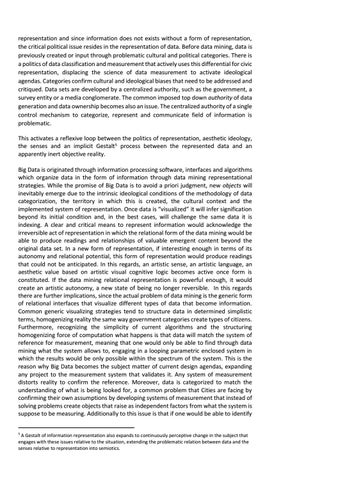representation and since information does not exists without a form of representation, the critical political issue resides in the representation of data. Before data mining, data is previously created or input through problematic cultural and political categories. There is a politics of data classification and measurement that actively uses this differential for civic representation, displacing the science of data measurement to activate ideological agendas. Categories confirm cultural and ideological biases that need to be addressed and critiqued. Data sets are developed by a centralized authority, such as the government, a survey entity or a media conglomerate. The common imposed top down authority of data generation and data ownership becomes also an issue. The centralized authority of a single control mechanism to categorize, represent and communicate field of information is problematic. This activates a reflexive loop between the politics of representation, aesthetic ideology, the senses and an implicit Gestalt5 process between the represented data and an apparently inert objective reality. Big Data is originated through information processing software, interfaces and algorithms which organize data in the form of information through data mining representational strategies. While the promise of Big Data is to avoid a priori judgment, new objects will inevitably emerge due to the intrinsic ideological conditions of the methodology of data categorization, the territory in which this is created, the cultural context and the implemented system of representation. Once data is “visualized� it will infer signification beyond its initial condition and, in the best cases, will challenge the same data it is indexing. A clear and critical means to represent information would acknowledge the irreversible act of representation in which the relational form of the data mining would be able to produce readings and relationships of valuable emergent content beyond the original data set. In a new form of representation, if interesting enough in terms of its autonomy and relational potential, this form of representation would produce readings that could not be anticipated. In this regards, an artistic sense, an artistic language, an aesthetic value based on artistic visual cognitive logic becomes active once form is constituted. If the data mining relational representation is powerful enough, it would create an artistic autonomy, a new state of being no longer reversible. In this regards there are further implications, since the actual problem of data mining is the generic form of relational interfaces that visualize different types of data that become information. Common generic visualizing strategies tend to structure data in determined simplistic terms, homogenizing reality the same way government categories create types of citizens. Furthermore, recognizing the simplicity of current algorithms and the structuring homogenizing force of computation what happens is that data will match the system of reference for measurement, meaning that one would only be able to find through data mining what the system allows to, engaging in a looping parametric enclosed system in which the results would be only possible within the spectrum of the system. This is the reason why Big Data becomes the subject matter of current design agendas, expanding any project to the measurement system that validates it. Any system of measurement distorts reality to confirm the reference. Moreover, data is categorized to match the understanding of what is being looked for, a common problem that Cities are facing by confirming their own assumptions by developing systems of measurement that instead of solving problems create objects that raise as independent factors from what the system is suppose to be measuring. Additionally to this issue is that if one would be able to identify 5
A Gestalt of information representation also expands to continuously perceptive change in the subject that engages with these issues relative to the situation, extending the problematic relation between data and the senses relative to representation into semiotics.
